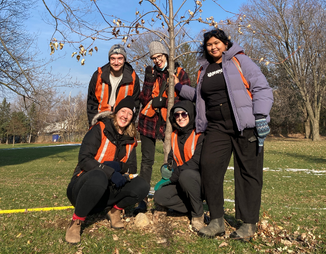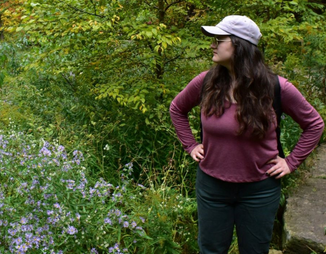
April 21, 2023
Justin Lewis
Tags: Backyard Biodiversity
Do you love butterflies and birds and want to welcome more of them to your yard? Planting native trees and shrubs in your yard is guaranteed to attract our fluttery and feathery friends!

April 14, 2023
Sarah G
Have you recently moved into a new development neighbourhood that is in need of some greenery but don’t know where to start? Shrubs are an easy way to kick off your backyard planting. Read more to learn about which native shrubs are best suited for your backyard!

March 27, 2023
Doreen Malapitan
Do you have compact clay soil in your yard? Do you ever notice water pooling in areas of your yard after a big rainfall? Do you find it difficult to grow certain plants in your garden? If you answered yes to any of these questions, we’ve got the answer for you – native shrubs that thrive in wet conditions!

March 22, 2023
Doreen Malapitan
Meet our Residential Planting Programs (RPP) team! They help grow and sustain the urban forest by assisting private property owners in planting the right native tree in the right place with the right care. With all their time spent around trees, they must have some tree-rific book recommendations! Let’s meet the RPP team and find out what their favourite tree books are!

March 16, 2023
Jon Curtis
Are you looking for a way to connect to your neighbourhood and nature this spring? Do-It-Yourself (DIY) tree planting is a fun and rewarding way to get your hands dirty while also helping grow the urban forest!

March 06, 2023
Lam Tran
After completing her undergrad, Sam was motivated to connect with others while establishing a career for herself in the environmental field. As a Young Urban Forest Leader (YUFL) in 2022, she was strengthened by the collective atmosphere of personal growth, community care and hope for the future alongside fellow young professionals. See how the YUFL program empowered Sam to grow her career.

March 03, 2023
Justin Lewis
Are you looking to make your Multi-Unit or Business property more beautiful, environmentally friendly and energy efficient? We help property owners in the City of Toronto, York Region, and most of Durham Region plant native trees and shrubs at subsidized rates. We understand that planting on Multi-Unit or Business properties can seem daunting at first. From tree selection to spacing requirements, we’ve heard your questions and we have the answers!

February 21, 2023
Lam Tran
Kathryn found herself in a position that may be relatable to other young adults: a strong desire to build a career, in her case in the environmental sector, but having limited work experience. Fortunately, through her participation in the Young Urban Forest Leaders (YUFL) Program, Kathryn found herself on a path to achieving her career goals!

February 16, 2023
Jess Wilkin
Tags: Invasive Species
Invasive species are no stranger to the urban forest. Dutch elm disease, emerald ash borer and spongy moth are a few of the destructive species we have become familiar with. The hemlock woolly adelgid is Ontario’s newest unwelcome pest but the good news is we can all take steps to help manage it.

January 24, 2023
Justin Lewis
Tags: Urban Forest Champion
Stacey Bowman has recently joined the LEAF Board of Directors. In this blog, our Acting Executive Director, Erin MacDonald interviews Stacey about her experience and motivation for becoming a LEAF Board member.
